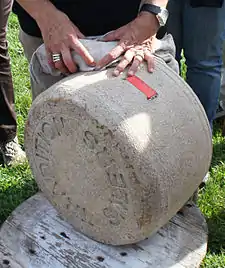Salers cheese
Salers (French: Le Salers) is a French semi-hard cheese from the volcanic region in the mountains of Auvergne, central France. It is a pressed, uncooked cheese made from Salers cow's milk between the fifteenth of April and the fifteenth of November. It is similar to Cantal cheese – which is produced from the same cows' milk when they are fed on hay during the remaining months of the year – and has been estimated to have been fabricated in this region for at least 2000 years. It came to prominence when Maréchal de Senneterre served it at the table of Louis XIV of France. Maréchal de Senneterre is also responsible for the introduction of Saint-Nectaire and Cantal. Salers has benefited from the Appellation d'origine contrôlée (AOC) since 1961.[1] It is best eaten between September and March, after an ageing time of nine months, but it is also excellent all year round.
| Salers | |
|---|---|
_01.jpg.webp) | |
| Country of origin | France |
| Region, town | Auvergne, Salers |
| Source of milk | Cow |
| Pasteurised | No |
| Texture | Semi-hard |
| Aging time | 9 months |
| Certification | French AOC 1961 |
Salers de Buron Traditional is only made up in the chalet (called a buron in the Auvergne) in the summer months with milk exclusively from the Salers cow. It must also be made in the traditional wooden gerle.[2]
It is circular in shape, weighing around 40 kilograms (88 lb).
1,112 tonnes were produced in 1998 (+15.1% since 1996). All was made in local farms from unpasteurized milk by about one hundred producers.

References
- Actimage. "Fiche produit". inao.gouv.fr. Retrieved 15 November 2015.
- Andy – Les Affinés. "Cheesy Adventures at Les Affinés". lesaffines.blogspot.co.uk. Retrieved 15 November 2015.